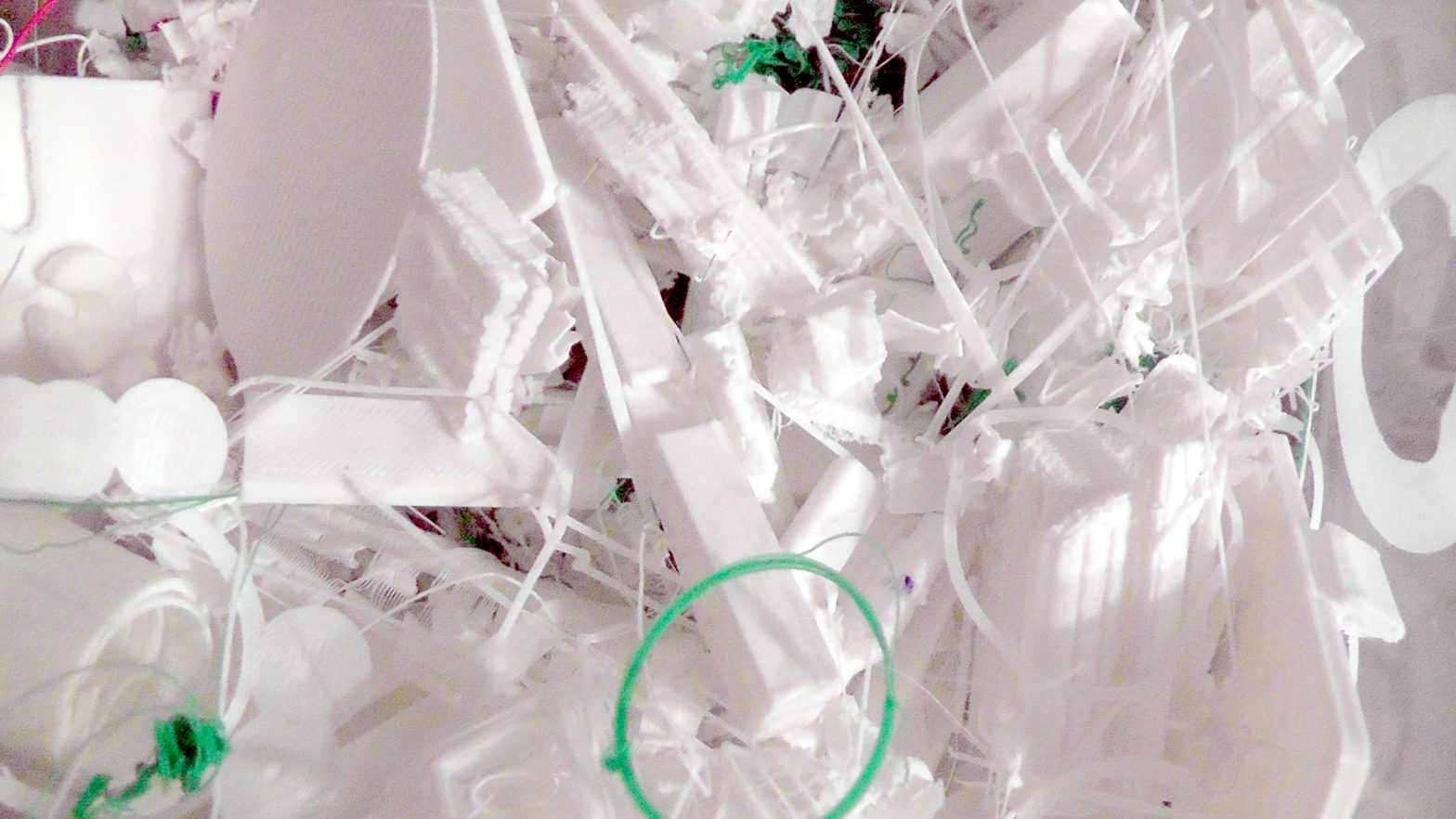DIY Recycling of Used Filament
Filament recycling machines exist. They operate similarly to how filament factories work. Most factories make filament from smooth beads, but if you recycle filament, you must get some kind of grinder, such as an old-style (non-crosscut) paper shredder to create course chunks from your leftover material. A hand-powered grinder may be the only way to get enough power without industrial equipment. I am keeping an eye out for filament recycling businesses, but I may have to buy my own filament extruder (become skilled at getting a good dimensional accuracy) or beg on the internet (Please, take my money and scraps, and give me filament.). The accuracy of the filament is difficult to maintain without industrial equipment, but with mastery and equipment tuning, someone may make recycled filament that is accurate enough for selling for 3D printing. Consistency (a dimensional accuracy of +/- 0.05 mm) is necessary for strength and a smooth finish on 3D prints (though an epoxy topcoat could save some prints). However, with 3D pens, such accuracy is not important. One could make or sell 3D filament with a wider tolerance that is still suitable for 3D pens. I recommend only recycling PLA and not other plastics if you do so at home (see below). You can also use chunks of the same plastic or other plastic or even plastic trash to build models or fix things without extruding (by melting, welding, or ironing; See “DIY Trash Recycling” and “Safety” below).
Identifying Plastics for DIY Trash Recycling
(usually the abbreviation appears somewhere on the item)
- ABS: Most electronic device shells are ABS (or ABS+PC or other blends for resilience such as for laptops).
- HDPE: Milk jugs, screw-on bottle or jug caps, and some other containers are HDPE.
- PET (not very good for extruding, and not the same as PETG): Most clear bottles are PET.
- PLA: Unfortunately, identifying and finding products packaged in PLA is difficult. A list of examples is difficult to find, as well. Plastics you can use for melting (thermoplastics) from the most common trash are not great for your breathing when melted. Please see “Safety” below.
- PP (polypropelene; challenging to print due to warping while cooling): most storage bins are PP.
Health and Safety
Regarding PLA, long-term effects are not known (Pelley, 2018). Most people use PLA for 3D printing. 3D printing is a more violent process than using a 3D pen and occurs at a much higher volume per time, but 3D pens also produce the waste gasses that occur by melting. The 3D printing revolution hasn’t revealed any publicized or published cases of issues at home or any clear issues with PLA. You can easily extrude several plastics from trash using a filament recycling machine, but I only recommend PLA for home use. PET (from clear bottles) is one of the safer materials to melt, but doesn’t extrude well. That is why it is usually chemically modified to make PETG for easier use with 3D printers.
Other plastics may significantly worsen air quality, at least in small, enclosed spaces. Filtering is one solution for the other plastics, but you must use a specialized activated carbon filter, not merely a HEPA or standard activated carbon filter (Why you won’t, 2018). HDPE and ABS can cause respiratory irritation, and long term exposure to any 3D printing may be unhealthy (Product safely assessment, 2014; Pelley, 2018). Other than exhausting or proper filtering, the other essential safety measure is avoiding burning plastic. You can find the temperature range for various plastics online (including from filament sellers in cases where the plastic is standard and not chemically modified for 3D printing in a way that changes the melting properties). Melting plastic generally produces safer waste gasses than burning plastic.
I don’t recommend heavy use or recycling of either HDPE or ABS without an enclosed area ventilated separately from your breathing space, or outdoors. Enclosed 3D printers with custom ventilation (negative pressure at the exit end of the duct, or an airtight system) are one possible solution for indoors. Therefore, for 3D pens, I recommend PLA (or PC for low-temperature pens) unless you do the recycling and 3D pen use outdoors. The environmental impact of melting thermoplastics that are available as filament is not considered significant, especially for PLA or low-temperature plastics made from organic materials. I wouldn’t recycle such filament at home, but you could buy it if you use it with ventilation. According to Direct Plastics Limited, even “welding plastics” that release a minute amount of waste gasses when melted (PET, Nylon, PP, PTFE, PVC), are not harmful to melt unless you work with them regularly in confined spaces (Whats in those, 2015). Personally, I even at least use an exhaust fan for 3D printing with PLA, and would be careful with any 3D extrusion with someone with respiratory sensitivities or pregnancy until there is more long-term data.
References
- Pelley, J. (2018, March 26). 3-D printer emissions raise concerns and prompt controls. Chemical & Engineering News. https://cen.acs.org/materials/3-d-printing/3-D-printer-emissions-raise/96/i13
- Product safely assessment: High Density Polyethylene (HDPE) resins. (2014). http://web.archive.org/web/20180920162319/http://msdssearch.dow.com/PublishedLiteratureDOWCOM/dh_091f/0901b8038091f9d5.pdf
- Whats in those fumes—About plastics. (n.d.). Retrieved January 3, 2020, from https://www.directplastics.co.uk/about_plastics/post/whats-in-those-fumes
- Why you won’t find a HEPA filter hanging on the back of our enclosures. (2018, December 20). Printed Solid. https://www.printedsolid.com/blogs/news/why-you-won-t-find-a-hepa-filter-hanging-on-the-back-of-our-enclosures
